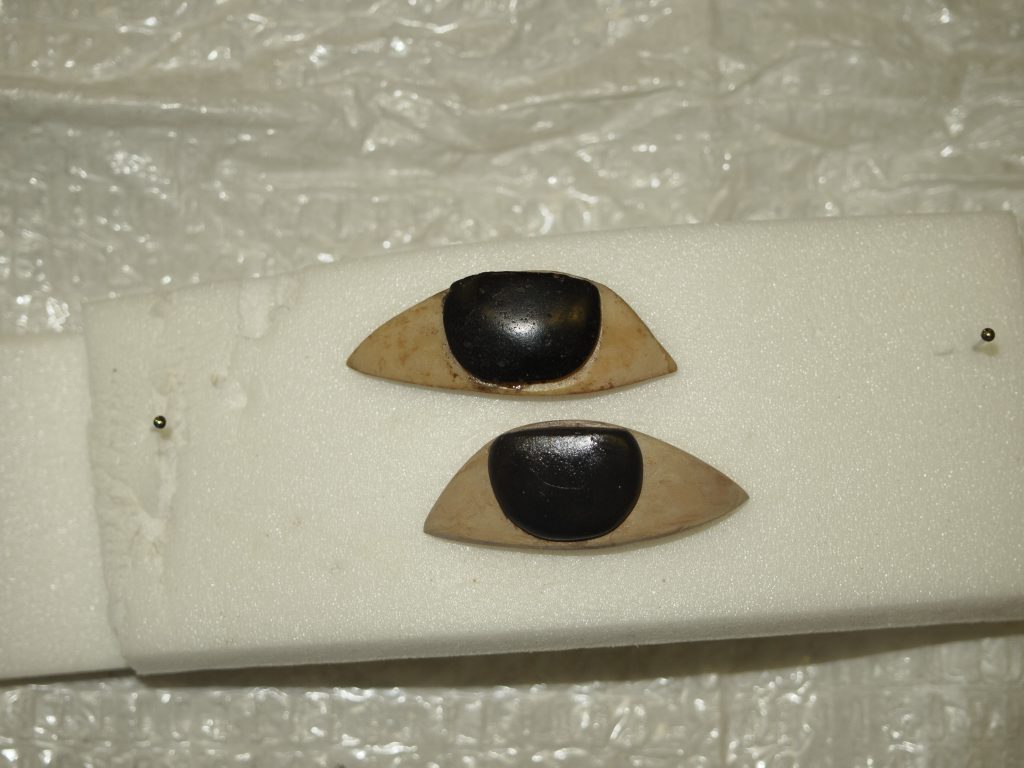By Tessa de Alarcon
Typically, at the Penn Museum when we are working on objects, even for display, we prioritize stability over aesthetics. This means that we are often do less cosmetic work than would be done at an art museum when it comes to putting in fills and toning out areas of loss. However, I recently undertook a project where I went further than I usually do to recreate lost material. This blog post is going to walk through why that decision was made in this case as well as some of the mysteries that I found along the way

The object in this case is an Egyptian cartonnage mask E1019. When it entered the lab it had a lot of condition issues, including the top of the head was partially crushed, it had been heavily treated before, and it was missing the inlays for its eyes and eyebrows. The missing eye inlays had been giving many visitors to the lab the creeps as the mask appeared to have dark empty eye sockets. Because of this, from the start I had been polling to my colleagues about what level of repair I should do to reduce the distraction of the missing inlays. I was not at this point considering replacing them, but was instead thinking about maybe toning out some of the other losses on the cheek to draw less attention to the eyes.

When it first entered the lab the mask was being tracked as E17632 but over the course of the treatment, I found a different accession number on the interior, E1019. With the help of our curators, we were able to piece together that E1019 was the original accession number, and E17632 had been assigned to it later. When I looked up the record for E1019 in the museum collection database, I found the record included two eye inlays! I was so hopeful that this would mean that I could reintegrate two inlays, one into each eye. However, when I reached out to the curators to get more information, I found out that they are two parts of the same eye, the white part of the eye and a pupil/iris.

Well, this left a new set of problems. Especially since you can see here, the white part of the eye was not very white anymore since it was covered with a dark brown substance. I was left with a lot of options, leave the eye inlays out, reintegrate them as they are, or clean them and reintegrate them, and if I reintegrated them should I then also create a replica set for the other eye?
Before making any decisions, I checked to see if they inlays fit the eye sockets in the mask, which they did. The inlays turned out to be for the masks right eye. After that, I spent some time characterizing the dark coating on the white part of the eye inlay. This included UV examination and comparing how the coating fluoresced with the brown modern materials I found on the interior of the mask from previous treatments. The results were not as clear cut as I was hoping. It seems that there is more than one brown substance on the inlay based on the UV examination. With this data in hand, I reached out again to the curators with the options of leaving the eyes out, reintegrating them as is, or cleaning and reintegrating. The curators indicated that they wanted the inlay reintegrated, and that they would like a replica for the missing inlay as well so that she looked even as one eye seemed worse than no eyes. Together we decided to clean the eye inlay, but to keep samples of the substances on the inlay for future analysis.

Once clean, I set about making a copy for the masks left eye to be a close but not identical match. Based on previous experience I decided to make the new inlay set out of a two-part light weight epoxy called Wood Epox as it is easy to shape and can be sanded and carved. To start, I made a paper template of the shape of each inlay. I made sure to mark what I wanted to be the front of each so that the shape would be a mirror image of the original inlay. The white inlay is slightly curved, so I also created a form that would have the same curvature using foam.

Next, I rolled out some sheets of wood epox, and using the paper template trimmed out the shape I needed for both parts of the eye. The pupil/iris part I let set flat, what let the one fore the white of the eye set in the form I had made so that it would have the same curvature as the original. Once cured I sanded them to finish, with the final stages being wet sanding so that the replica inlays would also have a natural gloss.

The final step before assembly and placement in the mask was the paint them to resemble but not exactly match the originals. I used gloss medium for the pupil/iris as this inlay was especially glossy and I could not get that level of gloss with polishing and painting alone.

Finally, here you can see the end results after treatment. You will see though, that I have not attempted to recreate the inlays for the eyebrows. Because we had the one set of eye inlays, I had something to reference for making the replica set of inlays, however, there are still pieces missing which I had no frame of reference for. There were also likely inlays that went around the outside of the eye as well. These and the brows might have been made out of a variety of materials and without the originals for reference, there is no way to be certain about what their color and appearance would have been.





































